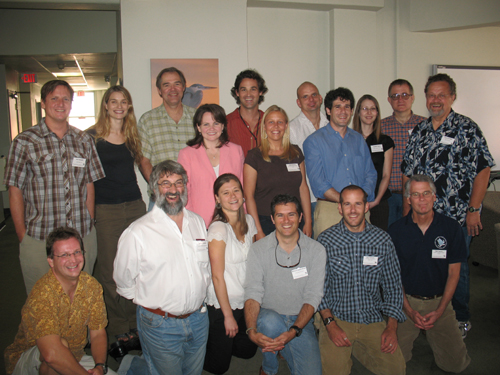NCEAS Working Groups
Exploring compensatory mitigation and markets as mechanisms for resolving fisheries bycatch: Biodiversity conservation conflicts
Project Description
The social and economic importance of fisheries and the biological realities of its impacts results in cardinal tensions over ocean resources. Fisheries provide approximately 16% of all protein consumed by humans and are valued at US$82 billion annually. However, eight percent of the global fishery catch is bycatch which is discarded; resulting in major impacts on marine systems. Increasingly, institutions are pressuring for sustainable management of species impacted by fisheries. Where bycatch cannot be avoided, fishery closures are being implemented, often driven by lawsuits, with costly outcomes for society. An offset approach to this conflict could facilitate high value uses of biological resources while making conservation gains for threatened species. Taking seabirds as an example, fishers could be levied for bycatch and capital transferred to fund conservation actions on breeding colonies (e.g., the removal of invasive mammals¿the primary threat to seabirds worldwide). A preliminary analysis has shown eradication of invasive predators can be 12 times more effective from an economic cost-conservation benefit perspective in comparison with fisheries closures. In addition, transferable bycatch fees, which could increase with endangerment, also provide individual incentives for avoiding bycatch, the most effective mechanism for sustainable management of fisheries. We are developing a general framework for this approach, using seabirds and sea turtles as case studies. Given limited conservation dollars, compensatory mitigation provides an opportunity to address a global concern, maximize the return on investment of conservation interventions, and forge an alliance between conservation and fisheries organizations, circumventing costly and socio-politically damaging battles over bycatch conflicts.

Principal Investigator(s)
Chris Wilcox, C. Josh Donlan
Project Dates
Start: May 14, 2007
End: November 21, 2008
completed
Participants
- Vanessa M. Adams
- James Cook University
- Peter Baxter
- University of Queensland
- Zachary Brown
- Duke University
- Stacey Buckelew
- Larry B. Crowder
- Duke University
- Richard Cudney-Bueno
- University of Arizona
- Paul Dalzell
- NOAA, National Marine Fisheries Service (NMFS)
- C. Josh Donlan
- Cornell University
- Kristen Fletcher
- Roger Williams University
- Heidi Gjertsen
- NOAA, Southwest Fisheries Science Center
- Alistair Graham
- World Wildlife Fund International
- Arlo Hemphill
- Great Wilderness
- Jennifer Lavers
- CSIRO Marine and Atmospheric Research
- James Mandel
- Cornell University
- Edward Melvin
- University of Washington
- Sean Pascoe
- CSIRO Marine and Atmospheric Research
- Hoyt Peckham
- University of California, Santa Cruz
- Oliver R.W. Pergams
- University of Illinois, Chicago
- Richard Rice
- Conservation International
- Raphael Sagarin
- Duke University
- Manuel R. Sequeiros
- Dale Squires
- NOAA, Southwest Fisheries Science Center
- Joe Sullivan
- Mundt MacGregor LLP
- Drew Tulchin
- Social Enterprises Associates
- Mary Turnipseed
- Duke University
- Chris Wilcox
- CSIRO Marine and Atmospheric Research
- Dana Wingfield
- University of California, Santa Cruz
Products
-
Report or White Paper / 2007
Maximizing return on investments for island restoration witha focus on seabird conservation
-
Report or White Paper / 2008
A path to a return on investment framework for island restoration with a focus on seabirds
-
Journal Article / 2008
Integrating invasive mammal eradications and biodiversity offsets for fisheries bycatch: Conservation opportunities and challenges for seabirds and sea turtles
-
Presentations / 2008
(Title Not Provided)
-
Presentations / 2008
(Title Not Provided)
-
Presentations / 2008
(Title Not Provided)
-
Report or White Paper / 2009
Maximizing return on investments for island restoration and seabird conservation in southeast Alaska, USA and British Columbia, Canada
-
Report or White Paper / 2009
Opportunities for using debt investment to link livelihood improvement and environmental conservation initiatives: A case study examining the tropical Pacific
-
Presentations / 2009
(Title Not Provided)
-
Presentations / 2009
(Title Not Provided)
-
Journal Article / 2009
Why environmentalism needs high finance
-
Presentations / 2010
(Title Not Provided)
-
Presentations / 2010
(Title Not Provided)
-
Presentations / 2010
(Title Not Provided)
-
Presentations / 2010
(Title Not Provided)
-
Presentations / 2010
(Title Not Provided)
-
Presentations / 2010
(Title Not Provided)
-
Presentations / 2010
(Title Not Provided)
-
Journal Article / 2010
Using expert opinion surveys to rank threats to endangered species: A case study with sea turtles
-
Journal Article / 2010
Bird demographic responses to predator removal programs
-
Journal Article / 2009
Debt investment as a tool for value transfer in biodiversity conservation
-
Journal Article / 2010
A derivative approach to endangered species conservation
-
Journal Article / 2011
Biodiversity offsets: A cost-effective interim solution to seabird bycatch in fisheries?
-
Journal Article / 2007
Resolving economic inefficiencies: Compensatory mitigation as a solution to fisheries bycatch-biodiversity conservation conflicts
-
Journal Article / 2009
Need for a clear and fair evaluation of biodiversity offsets for fisheries bycatch
